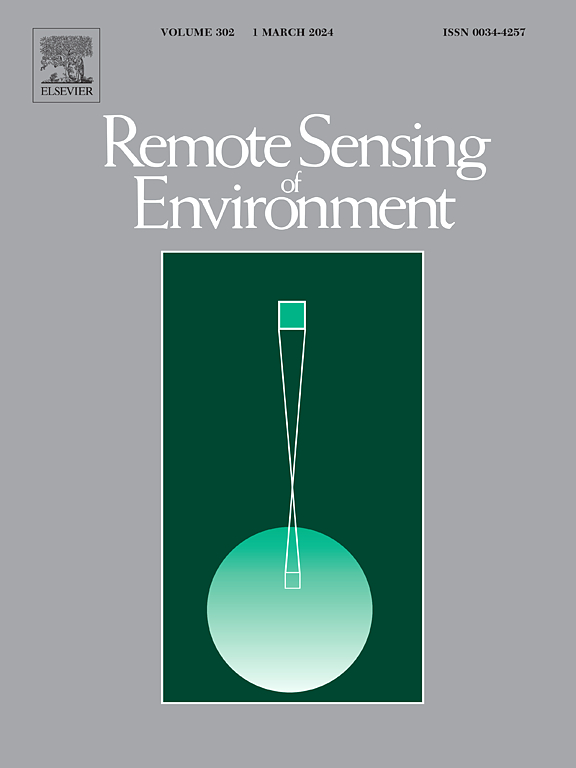Towards resolution enhancement of P-band brightness temperature data using passive-passive downscaling with L-band radiometer data
IF 11.1
1区 地球科学
Q1 ENVIRONMENTAL SCIENCES
引用次数: 0
Abstract
Current space-borne L-band radiometers have been routinely providing global soil moisture maps every 2 to 3 days for more than 15 years. However, they can only estimate soil moisture in the top 5 cm of the soil, which limits its usefulness in applications that need deep layer soil moisture. Fortuitously, recent work has shown that there is a potential to retrieve root zone soil moisture (RZSM) when combining P-band radiometer data with L-band radiometer data at the same spatial resolution. Nevertheless, there are antenna size limitations that currently restrict L-band radiometer data to a resolution of 40 km. Accordingly, if the same antenna is used for a joint P-band (750 MHz) and L-band (1.4GHz) satellite mission, the footprint size at P-band will be double that attained at L-band, limiting its usefulness in applications and making joint interpretation difficult. It is therefore essential to downscale the P-band radiometer measurements to at least the same resolution as the L-band measurements. Consequently, this paper has explored three alternative passive-passive P-band downscaling algorithms using the spatial information that exists in the L-band radiometer data, to achieve P-band brightness temperature (Tb) information at the same resolution as the L-band passive measurements. Analysis was conducted using data from three airborne campaigns in south-eastern Australia, with resolutions ranging from 36 km to 200 m under a range of moisture conditions and spatial characteristics. The three alternate downscaling algorithms used in this paper, designated as Algorithm A, B, and C, were not only compared to determine which generated the best performance, but were also analysed according to different land cover types and seasons. The results demonstrated that the Smoothing Filter-based Intensity Modulation (SFIM) method, referred to as Algorithm A, outperformed the others, with a median root mean square error (RMSE) compared to the original observations of 3 K when downscaling to half of the original spatial resolution, increasing to around 8 K when downscaling to 36 times finer than the original resolution.
利用l波段辐射计数据的被动-被动降尺度提高p波段亮度温度数据的分辨率
15年来,目前的星载l波段辐射计每2至3天提供一次全球土壤湿度图。然而,他们只能估计土壤顶部5厘米的土壤水分,这限制了它在需要深层土壤水分的应用中的实用性。幸运的是,最近的研究表明,当p波段辐射计数据与l波段辐射计数据在相同空间分辨率下结合时,有可能检索根区土壤水分(RZSM)。然而,由于天线尺寸的限制,目前l波段辐射计数据的分辨率限制在40公里。因此,如果将同一天线用于联合p波段(750兆赫)和l波段(1.4千兆赫)卫星任务,则p波段的占地面积将是l波段的两倍,从而限制了其在应用中的用处,并使联合判读变得困难。因此,必须将p波段辐射计的测量缩小到至少与l波段测量相同的分辨率。因此,本文探索了三种备选的被动-被动p波段降尺度算法,利用l波段辐射计数据中存在的空间信息,以获得与l波段无源测量相同分辨率的p波段亮度温度(Tb)信息。分析使用了澳大利亚东南部三次空降行动的数据,在一系列湿度条件和空间特征下,分辨率从36公里到200米不等。本文采用了三种备选降尺度算法,分别为算法A、算法B和算法C,通过比较确定哪一种算法的性能最好,并根据不同的土地覆盖类型和季节进行了分析。结果表明,基于平滑滤波器的强度调制(SFIM)方法(称为算法A)优于其他方法,当降尺度到原始空间分辨率的一半时,与原始观测值相比,中位数均方根误差(RMSE)为3 K,当降尺度到比原始分辨率细36倍时,增加到8 K左右。
本文章由计算机程序翻译,如有差异,请以英文原文为准。
求助全文
约1分钟内获得全文
求助全文
来源期刊

Remote Sensing of Environment
环境科学-成像科学与照相技术
CiteScore
25.10
自引率
8.90%
发文量
455
审稿时长
53 days
期刊介绍:
Remote Sensing of Environment (RSE) serves the Earth observation community by disseminating results on the theory, science, applications, and technology that contribute to advancing the field of remote sensing. With a thoroughly interdisciplinary approach, RSE encompasses terrestrial, oceanic, and atmospheric sensing.
The journal emphasizes biophysical and quantitative approaches to remote sensing at local to global scales, covering a diverse range of applications and techniques.
RSE serves as a vital platform for the exchange of knowledge and advancements in the dynamic field of remote sensing.
 求助内容:
求助内容: 应助结果提醒方式:
应助结果提醒方式:


